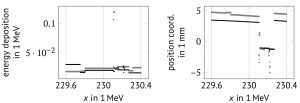Exploration of Differentiability
Algorithmic differentiation (AD) computes the accurate derivative at one particular point. Optimization benefits from AD gradients if they approximate the objective functions well in a larger neighborhoods. Using the example of a proton computed tomography (pCT) setup by the Bergen pCT collaboration involving a simulated human head and a digital tracking calorimeter, we have analyzed some algorithms from the high-energy physics (HEP) domain to determine whether they compute smooth functions.
Common tomographic reconstruction algorithms involve many discrete operations to check whether proton paths have crossed image voxels or not; accordingly, the reconstructed pCT image reacts to changes in the inputs mostly via jumps. When the binary condition is relaxed into a “fuzzy voxels” approach based on distance, derivatives represent the global behavior much better.
The Monte-Carlo simulation of the interaction of protons with the scanned object was done with GATE, a Geant4 application for medical imaging. We found that energy depositions in the detector are piecewise differentiable functions in the initial energy of the protons, but the jumps are much larger in magnitude than the continuous evolution in between the jumps.
Related publication: M. Aehle, J. Alme, G. Barnaföldi, J. Blühdorn, T. Bodova, V. Borshchov, A. van den Brink, V. Eikeland, G. Feofilov, C. Garth, N. R. Gauger, et al. Exploration of Differentiability in a Proton Computed Tomography Simulation Framework. Phys. Med. Biol. 68 (2023), 244002.
Tackling the Technical Challenge: Differentiating Geant4 with Derivgrind
The source code of GATE, together with the Geant4 toolkit and other dependencies, has more than one million lines. The technical challenge of differentiating such a large and complex codebase can be managed by using machine-code-based AD. After changing less than 20 lines of code to declare AD inputs and outputs and remove a “bit-trick”, our tool Derivgrind computes accurate derivatives of the energy depositions in the layers with respect to the primary energy. We verified this for the above pCT setup, simulating a single proton and comparing with difference quotients.
Related Publication: M. Aehle, L. Arsini, R. Belén Barreiro, A. Belias, F. Bury, S. Cebrian, A. Demin, J. Dickinson, J. Donini, T. Dorigo, M. Doro, N. R. Gauger, A. Giammanco, L. Gray, B. S. González, V. Kain, J. Kieseler, L. Kusch, et al. Progress in End-to-End Optimization of Detectors for Fundamental Physics with Differentiable Programming. arXiv:2310.05673 (2023).
Tackling the Mathematical Challenge: Smoother particle simulations
In practice, Geant4 simulations can involve many millions of particles. To investigate whether Geant4 inputs affect statistical quantities like average energy depositions mainly through jumps (which would be non-differentiable and make AD gradients useless) or through differentiable evolution (which is what AD computes), we applied CoDiPack to the compact G4HepEm/HepEmShow package for the simulation of electromagnetic showers in a sampling calorimeter with a simple and parametric geometry. We found that once multiple scattering is disabled in the simulation, mean pathwise derivatives deviate from the actual average of the mean energy deposition only by around 5%. In a simple optimization study conducted with our pathwise gradient estimator, a stochastic gradient descent optimizer still robustly converged to the minimum despite this small bias.

Related publication: M. Aehle, M. Novák, V. Vassilev, N. R. Gauger, L. Heinrich, M. Kagan, D. Lange. Optimization Using Pathwise Algorithmic Derivatives of Electromagnetic Shower Simulations. Computer Physics Communications 309 109491, 2025.
We have also created a prototypical forward-mode differentiated version of Geant4, with very similar findings on the accuracy of algorithmic derivatives.
Related publication: M. Aehle, X. T. Nguyen, M. Novák, T. Dorigo, N. R. Gauger, J. Kieseler, M. Klute, V. Vassilev. Efficient Forward-Mode Derivatives of Geant4. arXiv:2407.02966 [physics.comp-ph]


